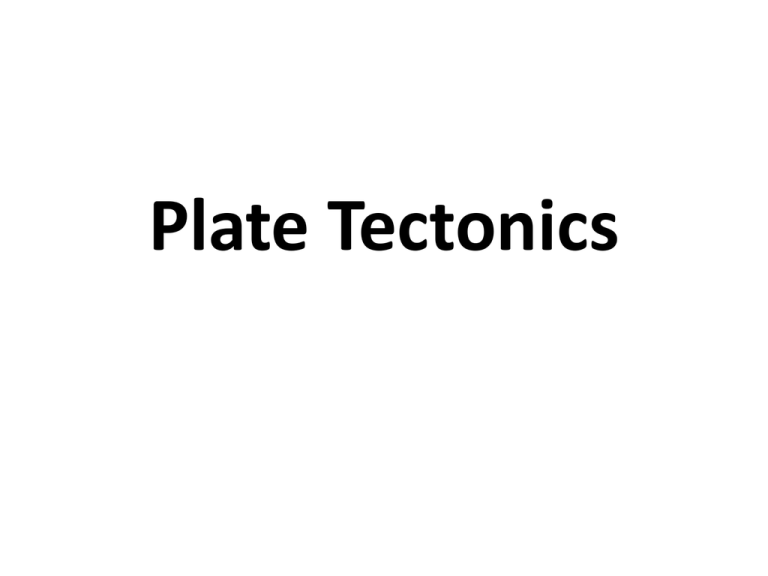Plate Tectonics
advertisement

Plate Tectonics Theory of Plate Tectonics • Explains the formation and movement of Earth’s plates (pieces of lithosphere) Wegener’s Hypothesis • Continents were once joined in a single supercontinent called Pangaea, which then broke apart to become our current continents • Move in process called “continental drift” Proof of Wegener’s hypothesis • Same fossils found on east coast of S. America and west coast of Africa • Continents look like they fit together like a puzzle. Problems with hypothesis • Unable to explain how continents could go through rock of sea floor • What force moved them? Sea Floor Spreading • Mapped ocean floor • Found underwater mountains called mid-ocean ridge Mid-ocean ridge • Youngest rock is in the middle of the ridge so must be coming up from underneath • 1960 Hess proposed sea floor spreading – process by which new oceanic crust is created, older crust moves away: magma is pulled up Sea Floor Spreading Subduction of Oceanic Plates • When spreading occurs, old oceanic plates sink into the mantle due to density • Occurs near edges of oceanic plates • When subducts, forms a depression in ocean floor called a trench Evidence of sea floor spreading • Sampled rocks on both sides of spreading • Found magnetic stripes based on magnetic fields that were identical Cause of plate movements • Convection currents from in mantle • Hot rock rises at mid-ocean ridges, cools and spreads out horizontally, then sinks back down. Where does the heat come from? • Gradual cooling of Earth’s interior • Decay of radioactive isotopes Plate Boundaries • A dozen or so major plates • Contain both continental and oceanic crust • Where the plates meet are called boundaries Three types of Boundaries • Divergent – move away from each other • Convergent – move towards each other • Transform – slide past each other • Plates move about 0.1-10 centimeters/year Divergent • cotf.edu Convergent Boundaries • earth.usc.edu Transform Boundaries • gweaver.net Mountain Building • Form along plate boundaries • Two plates collide, but neither is subducted (Ex. Himalayas) Or • When oceanic plate collides with continental plate (Ex. Andes) Mountain building Or • Two diverging plates (Ex. Mid ocean ridge) – can rise above sea level to produce an island (Ex. Iceland) Earthquakes • Movement of Earth’s lithosphere when rock in the lithosphere suddenly shifts, releasing stored energy • energy is carried by seismic waves • Where it begins is the focus • Epicenter is the land above the focus Tsunami • A large sea wave generated by an underwater earthquake, volcano, or landslide • Reach speeds of 500 mph, heights of 30-70 ft. Types of Seismic waves • P wave – longitudinal waves –Fast –First to be detected at a distance –Travel through solid and liquids Types of Seismic waves • S wave – transverse waves – Can’t travel through liquids • Surface wave – develop when seismic waves reach the Earth’s surface – Move slower than P and S waves – Cause more damage Measuring Earthquakes • Use seismographs to pinpoint epicenters • Richter scale – rates earthquakes on times and amplitudes of seismic waves • Moment Magnitude scale – measures amount of energy released – Each number represents 32 x increase in energy Modified Mercalli scale – scale of 1-12 based on intensity of ground shaking and damage rating of 12 causes total destruction of towns and cities Where do earthquakes occur? • Along boundary plates • San Andreas Fault in California Stress in the Earth’s Crust • Faults – a break in mass of rock along which movement occurs • Fold – bend in layers of rock Volcanoes • A mountain that forms when magma reaches the surface How a volcano erupts • Magma under pressure rises to the surface • When it gets closer to surface, pressure is lower so gases (carbon dioxide and water vapor) expand rapidly Structure of a volcano mail.colonial.net Volcano terms • Magma chamber – place where magma gathers before blowing • Vent – opening in ground where magma escapes • Crater – top of central vent, bowl shaped • Caldera – depression at top of volcano when central vent and magma chamber collapse inward Magma • Three factors determine viscosity –Temperature – higher = low viscosity –Water content – higher = low viscosity –Silica content – high silica = high viscosity Quiet Eruptions • Magma is very hot and low silica • Get lava flows –Two types of lava • Pahoehoe – hot, fast moving • Aa – cooler, slow-moving Explosive Eruptions • High silica – thick magma clogs vent pipe and pressure builds until it blows • Lava and gases are thrown outward • Lava solidifies quickly and shatters into pieces • Fine dust, ash, pebble-sized to car-sized Mt. Krakatau Location of volcanoes europlanet.dlr.de Location of volcanoes • Along plate boundaries or hot spots • Hot spot – region where hot rock extends from deep within the mantle to the surface • Three types of volcanoes: – Shield - wide, flat volcano formed from lava – Cinder - small, steep sided formed from ash/cinders – Composite – forms from explosive eruptions that produce lava and ash Other igneous rock features • Batholiths – from core of mountain range, large intrusive rock mass • Sill – formed when magma hardens in a crack parallel to existing rock layers • Dike – formed when magma hardens in a crack that cuts across rock layers • Volcanic neck – formed when magma hardens in pipe








